13-inch Retina MacBook Pro Review (Late 2012)
by Anand Lal Shimpi on November 13, 2012 2:53 AM ESTEarlier this year Apple introduced its first Mac equipped with a Retina Display. The 15.4-inch MacBook Pro with Retina Display (henceforth rMBP) introduced a brand new, thinner and lighter chassis to the MacBook family while serving as the launch vehicle for the world's first 2880 x 1800 notebook display.
Although the 15-inch rMBP was significantly more portable than its predecessor, the number one question asked after its release was when the MacBook Air would get similar Retina Display treatment. As the first Mac with an ultra high resolution IPS panel, the value of the 15-inch rMBP was obvious, but these days the market demands extreme portability.
Over the past few years, the 13-inch notebook form factor emerged as a great balance between functional size and portability. Although many hoped for a MacBook Air equipped with a Retina Display, for the follow on to the 15-inch rMBP Apple made the logical progression and brought a Retina Display to its 13-inch MacBook Pro.
In doing so, the 13-inch MacBook Pro with Retina Display gets all of the chassis improvements that were first introduced with the 15-inch model this summer. Apple ditched the optical drive, slimmed up the notebook, and integrated Intel's 22nm Ivy Bridge silicon. Better speakers, a larger battery, USB 3.0, and an extra Thunderbolt port are all a part of the next-gen package.
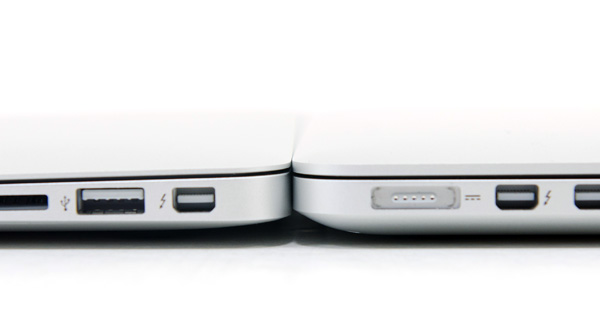
13-inch MBA (left) vs. 13-inch rMBP (right)
By virtue of the smaller display size and the next-gen MacBook Pro chassis, the 13-inch rMBP does a lot to blur the line between the Air and Pro lines.
13-inch rMBP: Form Factor Perfection?
I always liked the 13-inch form factor of the MacBook Pro, but I never liked the laptop itself. It always had too low resolution of a screen to be productive and it was too big and heavy to make sense compared to the MacBook Air. Once the 13-inch MacBook Air got Sandy Bridge, I pretty much stopped recommending the 13-inch MacBook Pro. You got a lower resolution display, and didn't gain enough to make the tradeoff worthwhile. Upgradability was a definite advantage, but most of the time when I'm making a personal recommendation to someone it's a person who isn't going to upgrade their machine regardless. When Apple revealed that the 13-inch MacBook Pro was still its best selling notebook, I was a bit surprised - although it did make sense.
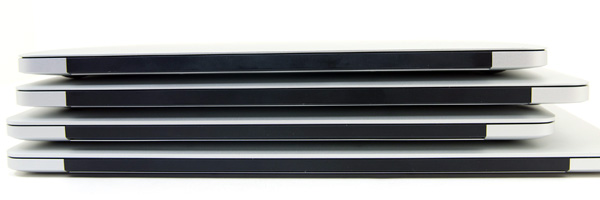
From top to bottom: 11-inch MBA, 13-inch MBA, 13-inch rMBP, 15-inch rMBP
The new 13-inch MacBook Pro with Retina Display changes all of that entirely. I'm now finding it more difficult to recommend the 13-inch MacBook Air, and have almost every reason to recommend the new Pro. The reduction in chassis thickness and weight give it an almost ultraportable feel. At 3.57 pounds, the 13-inch rMBP is light enough that traveling with it isn't a problem. Thanks to the smaller display, pulling it out on a crowded airplane in coach and getting work done isn't an issue either. The larger 15-inch rMBP still struggles in the airplane use case, although the reduction in thickness made it a bit better than its non-Retina predecessor.
| MacBook Pro with Retina Display Comparison | ||||||
| 15-inch MacBook Pro with Retina Display | 13-inch MacBook Pro with Retina Display | 13-inch MacBook Pro | 13-inch MacBook Air | |||
| Dimensions | 0.71 x 14.13 x 9.73" | 0.75 x 12.35 x 8.62" | 0.95 x 12.78 x 8.94" | 0.11 - 0.68 x 12.8 x 8.94" | ||
| Weight | 4.46 lbs (2.02 kg) | 3.57 lbs (1.62 kg) | 4.5 lbs (2.06 kg) | 2.96 lbs (1.35 kg) | ||
| CPU | Core i7-3615QM | Core i5-3210M | Core i5-3210M | Core i5-3427U | ||
| CPU Cores/Threads | 4/8 | 2/4 | 2/4 | 2/4 | ||
| L3 Cache | 6MB | 3MB | 3MB | 3MB | ||
| Base CPU Clock | 2.3GHz | 2.5GHz | 2.5GHz | 1.8GHz | ||
| Max CPU Turbo | 3.3GHz | 3.1GHz | 3.1GHz | 2.8GHz | ||
| GPU | Intel HD 4000 + NVIDIA GeForce GT 650M | Intel HD 4000 | Intel HD 4000 | Intel HD 4000 | ||
| GPU Memory | 1GB GDDR5 | - | - | - | ||
| System Memory | 8GB DDR3L-1600 | 8GB DDR3L-1600 | 4GB DDR3-1600 | 4GB DDR3L-1600 | ||
| Primary Storage | 256GB SSD | 128GB SSD | 500GB 5400RPM HDD | 128GB SSD | ||
| Optical Drive | N | N | Y | N | ||
| Display Size | 15.4-inches | 13.3-inches | 13.3-inches | 13.3-inches | ||
| Display Resolution | 2880 x 1800 | 2560 x 1600 | 1280 x 800 | 1400 x 900 | ||
| Thunderbolt Ports | 2 | 2 | 1 | 1 | ||
| USB Ports | 2 x USB 3.0 | 2 x USB 3.0 | 2 x USB 3.0 | 2 x USB 3.0 | ||
| Other Ports | SDXC reader, HDMI out, headphone out | SDXC reader, HDMI out, headphone out | GigE, FireWire 800, SDXC reader, headphone out | SDXC reader, headphone out | ||
| Battery Capacity | 95 Wh | 74 Wh | 63.5 Wh | 50 Wh | ||
| Price | $2199 | $1699 | $1199 | $1199 | ||
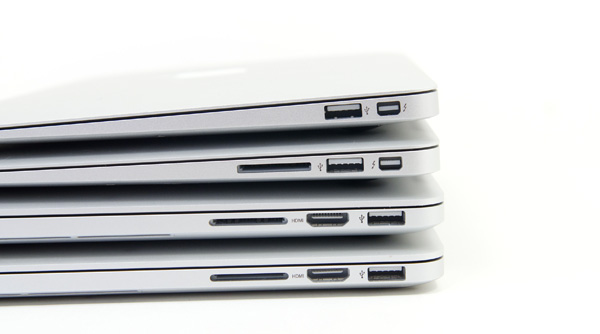
From top to bottom: 11-inch MBA, 13-inch MBA, 13-inch rMBP, 15-inch rMBP
The dimensions are very surprising. The 13-inch rMBP maintains a uniform thickness of 0.75-inches, 5.6% thicker than the 15-inch model (but obviously with less total volume thanks to a smaller planar footprint). Compared to the thickest point on the 13-inch MacBook Air however you're only gaining 0.07-inches. The weight difference is marginal as well. The 13-inch MBA shaves off only 0.61 lbs. The 15-inch rMBP is less than a pound heavier as well (0.89 lbs). Apple has done its best to make your decision about picking the right screen size and internals, almost entirely removing things like weight from the discussion. While the 13-inch MBA is still clearly a more portable device, I believe with the 13-inch rMBP Apple has built a chassis that's truly an alternative.
The downside to all of this is a machine that really can't be upgraded. Apple outfits all of the 13-inch rMBPs with 8GB of DDR3L-1600, although there's no BTO option for 16GB of RAM (which is availble on the 15). The integrated SSD module is removable, although it's not intended to be user serviceable. I don't believe the 8GB memory limitation will be much of an issue over the useful life of the system. If we assume 8GB is enough for the foreseeable future, providing more (or easily upgradeable) storage is my biggest complaint about the fairly fixed configuration. The good news is the SSD module can be upgraded and some companies do offer an upgrade path for it. We've already grown used to having notebooks with integrated batteries and CPUs soldered down to the motherboard, which makes the rMBP pill a lot easier to swallow.
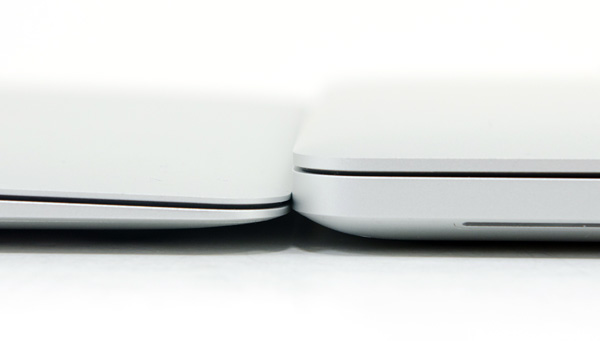
13-inch MBA (left) vs. 13-inch rMBP (right)
I appreciate the fact that there's no reduction in IO when moving between the 13 and 15-inch rMBPs. The 13-inch model retains the two USB 3.0 ports, two Thunderbolt ports, headphone/mic jack, SD card reader, and HDMI out of its bigger brother. Apple's MagSafe 2 connector makes an appearance as well.
The keyboard and trackpad remain very similar to the 15-inch model, although I feel like there's slightly more key travel on the 13. Neither system has the key travel of the older, non-Retina MacBook Pros but that's a sacrifice that seems like we'll be making more of as we pursue even thinner designs. I do believe that despite Apple's pursuit of a very thin chassis that it continues to deliver a very usable keyboard with great feel. I've typed tens of thousands if not hundreds of thousands of words on Apple's current crop of keyboards, and they still manage to hold up quite well.
The trackpad shares a similar story. The glass covered trackpad of the 13-inch rMBP is similar in size and identical in feel to the trackpad on the rest of Apple's mobile lineup. The 13's trackpad performance and behavior remains among the best in the industry.


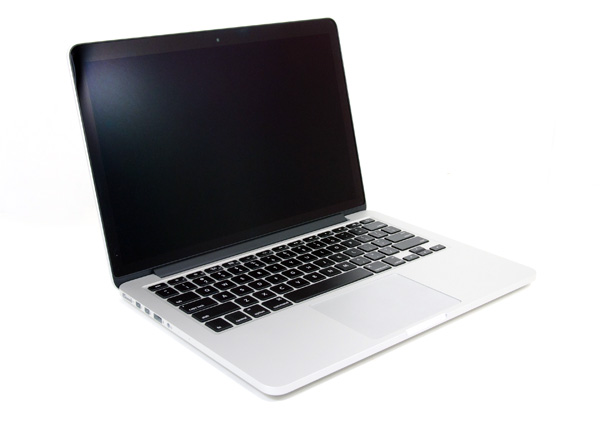










79 Comments
View All Comments
James5mith - Tuesday, November 13, 2012 - link
One of the biggest advances the Windows OS made was moving from a strictly CPU driven windows management interface, to a GPU accelerated one. (Vista, Win7, Win8)It stopped things like the classic "trail of artifact windows" you could do when your old WindowsXP and earlier machines were bogged down. Since the desktop was drawn by the CPU, it wouldn't refresh properly until some CPU cycles were freed up.
Seems Apple did not learn from the past, and is now doomed to repeat it.
Ryan Smith - Tuesday, November 13, 2012 - link
Actually Apple introduced GPU accelerated window composition with Quartz Extreme nearly 10 years ago, a few years ahead of Microsoft.However there are several layers to GPU acceleration. The earliest solutions could do window composition on the GPU, but the contents of the windows themselves were still generated by the CPU. Since then both MS and Apple have been moving more and more of the workload on to the GPU as it makes sense to do so. But no one is 100% offloaded, so the CPU still plays a part and consequently can still be a bottleneck.
michal1980 - Tuesday, November 13, 2012 - link
The bias is strongsolipsism - Saturday, November 17, 2012 - link
Yes, the bias is strong... in you.<ul><li><a href="http://www.anandtech.com/tag/windows-8>http://w...
cjs150 - Tuesday, November 13, 2012 - link
But not yet. One maybe two generations to go before perfect.1. One obvious use of this will be to watch movies on go (especially on long business trips) but once again Apple ignores 1080p resolution (if there someone at Apple who hates this resolution, because they try and ignore it in every device they produce)
2. Card reader is flaky - is it because of chassis flex or just a bad reader?
3. storage needs to be bigger, I gues next generation will be 256gb.
4. A bit extra horse power obviously needed, but probably not a lot.
The real question though is as tablets get better, is there any point in the 13" Mac?
xTRICKYxx - Tuesday, November 13, 2012 - link
What software do you use to test the framerates of the browser?Jorange - Tuesday, November 13, 2012 - link
$1700 and laggy UI. Come on Apple fans admit that you buy their products for the image, and for fear of being seen as gauche in the eyes of your vapid clique. The best Apple zealots are those whom purchase the things on credit, look how wealthy I am, whilst paying off the monthly installments:)boblozano - Tuesday, November 13, 2012 - link
This is the first review that I've read that captures the essence of this machine -- it is a machine of excellent balance, and in that balance lies it's real reason for being.Came from a mid-2011 mbair (1.8 i7, 256gb), and before that a mid-2009 mbp 15. Workload is a mix of writing, photo editing (lr, ps, etc.), and some video creation. Lots of travel. Went to the mbair after good friends with a heavy dev emphasis swore it was excellent. It was/is.
Considered the 15 rMBP since the price is effectively the same, and there is obviously more of just about everything. But size for travel and general mobility was a significant concern (the air allowed me to switch from a full-size backpack to a much smaller messenger bag).
The reason why I've settled on 13 as just about perfect for my present usage is simple: with the increasing number of full-screen apps, 13" is just about perfect for writing in a full screen, while 15 just feels overwrought. Even better, with retina the photo and video editing remains very usable.
With that as a background, the 13" rMBP was a real step up in everything that I liked about the air, with hardly any compromise (small bit of weight). Ended up with the 2.9 I7, 512gb. Everything I do is faster, better (though definitely not cheaper), and that screen just makes you smile when opening it up to work. It is good enough that I'm even going back to using the device open on a stand (trying the new twelve south height-adjustable stand) when docked.
Sure it would be nice to have 4 cores and a discrete gpu (particularly for rendering), but as of now there's no doubt it would have compromised mobility and/or battery life. About the only indisputable criticism is one of value, but such is life.
Undoubtedly (and always) there'll be something much better down the road, maybe even only a year from now. Good. But as of today, this is the best computing device I've ever used on a daily basis.
caleblloyd - Tuesday, November 13, 2012 - link
Anand - the Primary Storage for the 13in MBA that you have listed on the table on the first page should be 128GB.repoman27 - Tuesday, November 13, 2012 - link
"In reality USB 3.0 is good for about 400 - 500MB/s (3.2Gbps - 4.0Gbps)..."The actual reality is that USB 3.0 provides a physical layer gross bit rate of 5 Gbit/s, and a physical layer net bit rate of 4 Gbit/s due to 8b/10b encoding. The net bit rate delivered to the application layer is unlikely to ever exceed 80% of that, or 400 MB/s, in the real world. Even using UASP, which clearly looks to be the case in these tests, I've never seen peak SuperSpeed USB transfer rates much in excess of 350 MB/s. USB 3.0 is good for 300 - 350 MB/s with the hardware shipping at this point, although we may see the upper bound approach 400 MB/s in the future.
"This is Intel's most capable Thunderbolt SKU as it takes four PCIe 2.0 lanes combined with DisplayPort and muxes them into four Thunderbolt channels (2 up/2 down) with two DP outputs."
This sentence has some problems as well. The DSL3510L has connections on the back end for 4 PCIe 2.0 lanes, 2 DisplayPort 1.1a sources and 1 DisplayPort 1.1a sink. On the front side it has four 10 Gbit/s, full-duplex Thunderbolt channels, 2 per port (i.e. 2 up/2 down per port or 4 up/4 down per controller). Each port can also operate in legacy DisplayPort signaling mode when a DisplayPort device is connected directly.
On another note, it's frustrating that Apple failed again at the SDXC card reader, and it appears to be a mechanical issue once again. iFixit's teardown photos seem to have omitted it, but if Apple used the same controller as in the 15-inch MBPR, then it's a Broadcom controller that supports SD 3.0 features such as SDXC and UHS-I paired with a PCIe 1.1 x1 back end. This should make it far more capable than a USB 2.0 based solution, but no, instead they made it useless because half the time it doesn't read a card at all when inserted.